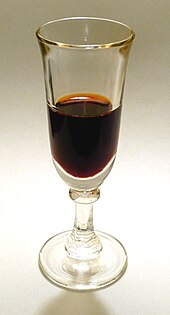Tincture

A tincture is typically an alcoholic extract of plant or animal material or solution of such or of a low volatility substance (such as iodine and mercurochrome). To qualify as an alcoholic tincture, the extract should have an ethanol percentage of at least 25–60% (50–120 US proof).[citation needed] Sometimes an alcohol concentration as high as 90% (180 US proof) is used in such a tincture.[1] In herbal medicine, alcoholic tinctures are made with various ethanol concentrations, 25% being the most common.
Herbal tinctures are not always made using ethanol as the solvent, though this is most commonly the case. Other solvents include vinegar, glycerol, diethyl ether and propylene glycol, not all of which can be used for internal consumption. Ethanol has the advantage of being an excellent solvent for both acidic and basic (alkaline) constituents.
Glycerine can also be used, but when used in tincturing fashion is generally a poorer solvent. Vinegar, being acidic, is a better solvent for obtaining alkaloids but a poorer solvent for acidic components. For individuals who choose not to ingest alcohol, non-alcoholic e,g., (glycerite) extracts offer an alternative for preparations meant to be taken internally.
Some solutions of volatile or nonvolatile substances are traditionally called spirits, regardless of whether obtained by distillation or not and whether or not they even contain alcohol. In chemistry, a tincture is a solution that has alcohol as its solvent.
Method of preparation
- Herbs are put in a container and a spirit of 40% or more ethanol is added, for example, 80 proof vodka or 190 proof rectified spirit (such as Everclear).
- The jar is left to stand for 2–3 weeks and shaken occasionally in order to maximize extraction.
More accurate measuring can be done by combining 1 part herbs with a water-ethanol mixture of 2–10 parts, depending on the herb itself. For most tinctures, however, 1 part water to 5 parts ethanol is typical.[1]
Examples
Some examples that were formerly common in medicine[2] include:
- Tincture of Benzoin
- Tincture of cannabis
- Tincture of cantharides
- Tincture of Castoreum
- Tincture of ferric citrochloride, a chelate of citric acid and Iron(III) chloride
- Tincture of green soap, which classically contains lavender oil
- Tincture of guaiac gum
- Tincture of iodine
- Tincture of opium, (laudanum)
- Camphorated opium tincture (paregoric)
- Tincture of Pennyroyal
- Warburg's Tincture, ("Tinctura Antiperiodica" or "Antiperiodic Tincture", a 19th-century antipyretic)
Examples of spirits include:
- Spirit of ammonia (spirits of hartshorn)
- Spirit of camphor
- Spirit of ether, a solution of diethyl ether in alcohol
- "Spirit of Mindererus", ammonium acetate in alcohol
- "Spirit of nitre" is not a spirit in this sense, but an old name for nitric acid (but "sweet spirit of nitre" was ethyl nitrite)
- Similarly "spirit(s) of salt" actually meant hydrochloric acid. The concentrated, fuming, 35% acid is still sold under this name in the UK, for use as a drain-cleaning fluid.
- "Spirit of vinegar" is an antiquated term for glacial acetic acid
- "Spirit of vitriol" is an antiquated term for sulfuric acid
- "Spirit of wine" or "spirits of wine" is an old term for alcohol (especially food grade alcohol derived from the distillation of wine)
- "Spirit of wood" referred to methanol, often derived from the destructive distillation of wood
Advantages
Ethanol is able to dissolve substances which are less soluble in water, while at the same time the water content can dissolve the substances less soluble in ethanol. One can sometimes vary the proportion of ethanol and water to produce tinctures with different characteristics due to the distinct solvent properties of these two. Tincture of calendula is commonly tinctured at either 25% or 90% ethanol. The alcohol content also acts as a preservative.It is widely employed as solvent for extraction.
Disadvantages
Ethanol has a tendency to denature some organic compounds, rendering them so changed as to be ineffective. This is one reason why ethanol is an antimicrobial. This tendency can also have undesirable effects when extracting botanical constituents, for instance, polysaccharides. Certain other constituents, common among them proteins, can become irreversibly denatured, or "pickled" in a manner of speaking. Also, extracted for highly complex aromatic components are denatured by alcohol's intrinsic cleaving action upon an aromatic's complex structure into simpler inert-rendered compounds. A basic tenet of organic chemistry teaches that any time a biologically viable component is denatured, it will reduce or negate its prior biological viability. This fact must be considered by the clinician and/or consumer from both the standpoint of efficacy and dosage when choosing ethanol-based botanical tinctures.
Ether and propylene glycol based tinctures are not suitable for internal consumption, although they are used in preparations for external use, such as personal care cremes and ointments.
See also
- Nalewka - a traditional Polish category of alcoholic tincture.
- Infusion - a water or oil based extract with similar historical uses to a tincture.
- Elixir - A pharmaceutical preparation containing an active ingredient that is dissolved in a solution containing some percentage of ethyl alcohol.
- Extract
- Topical - categorization of topical skin preparation options






